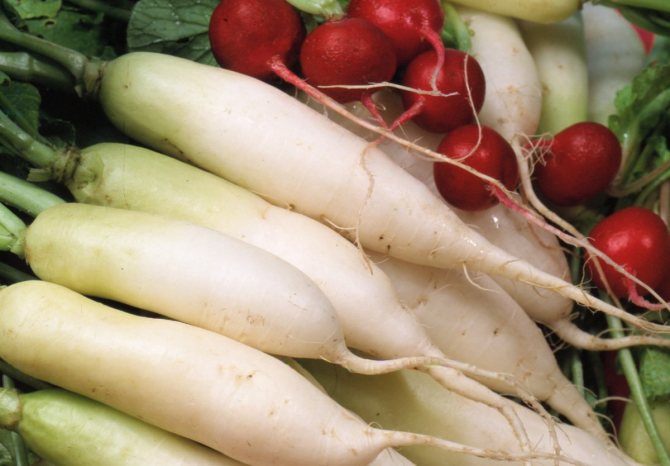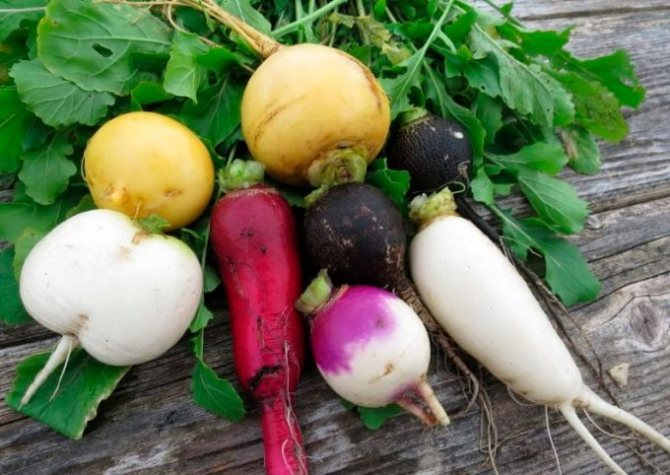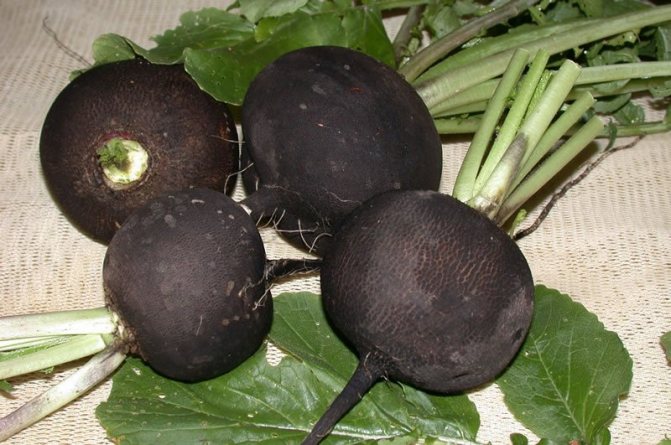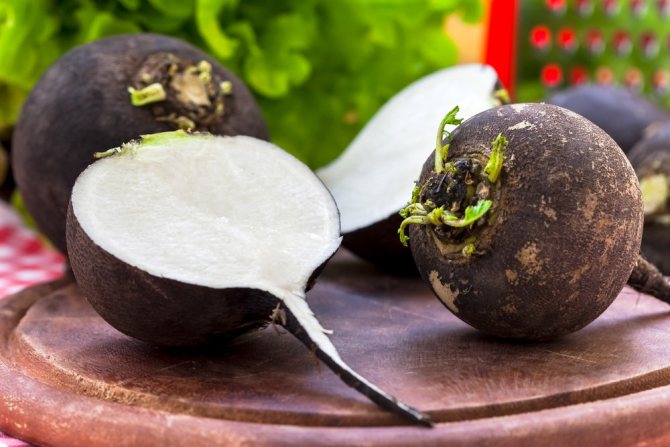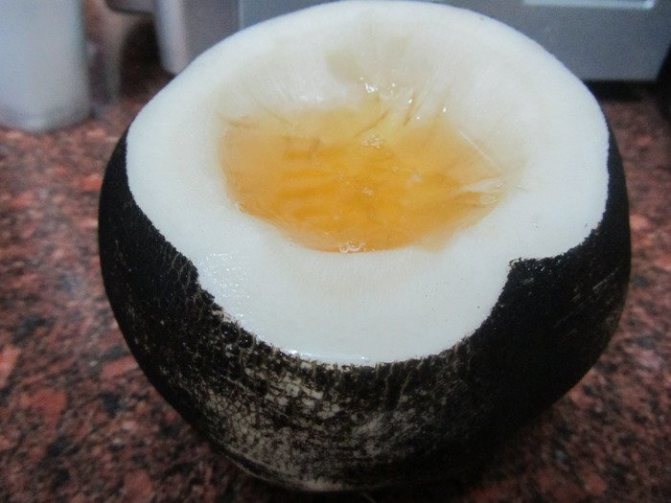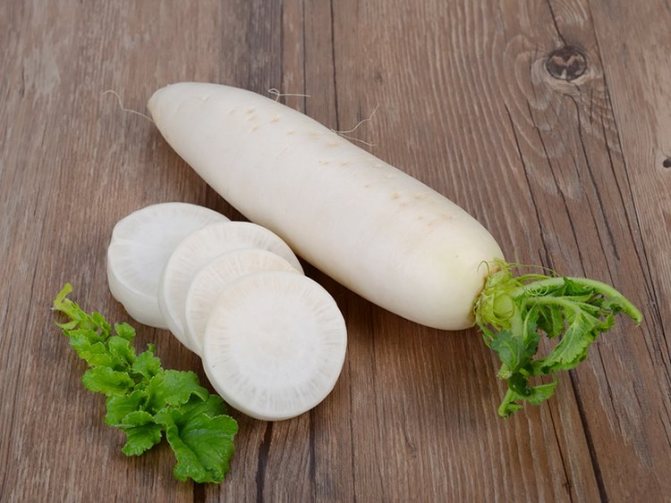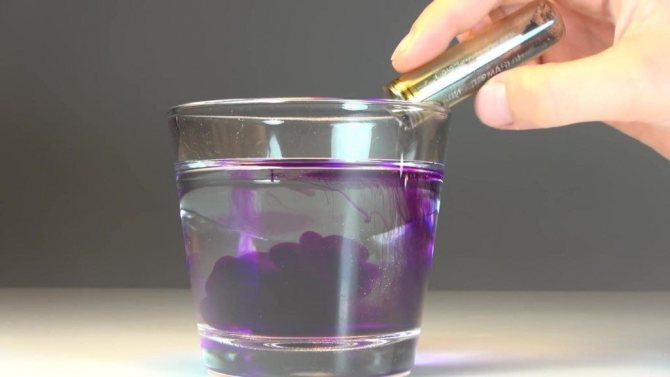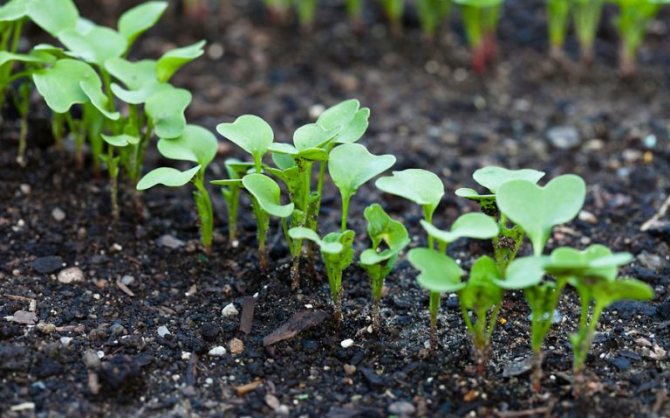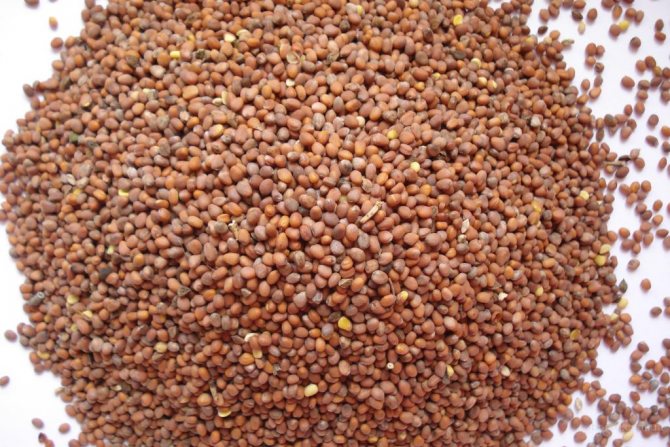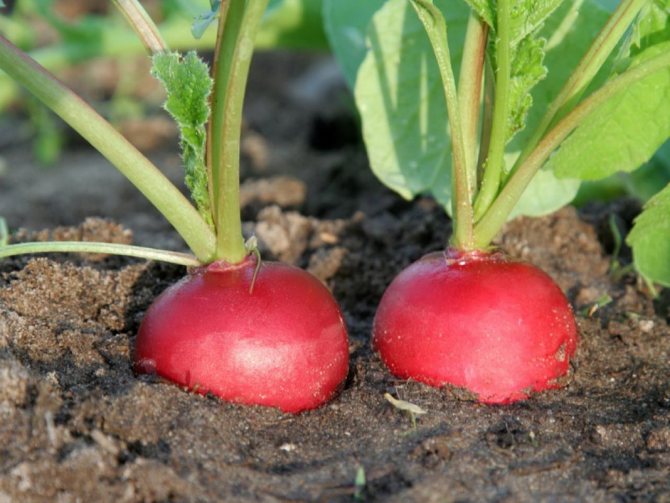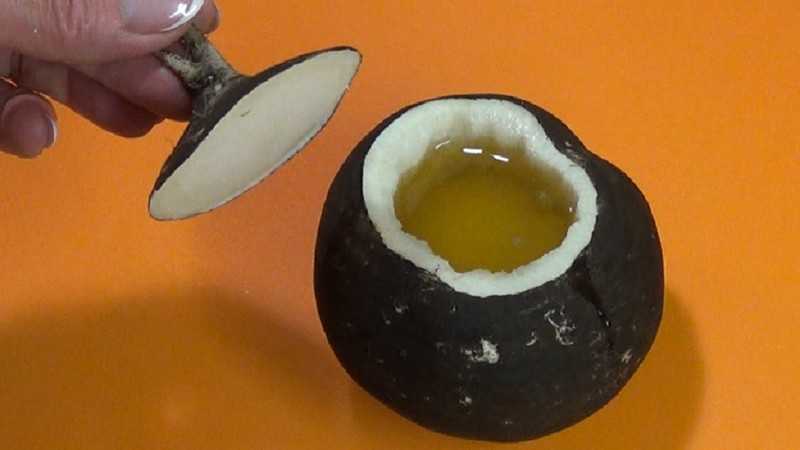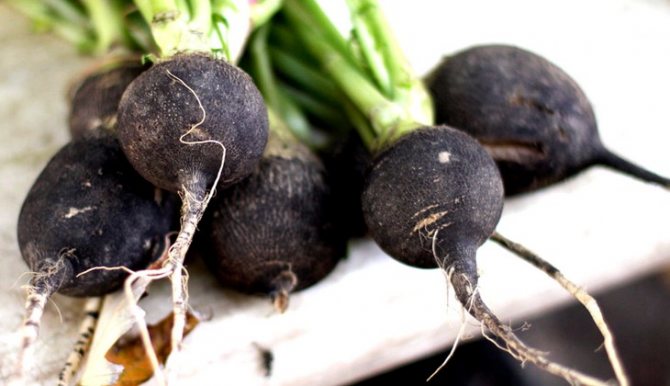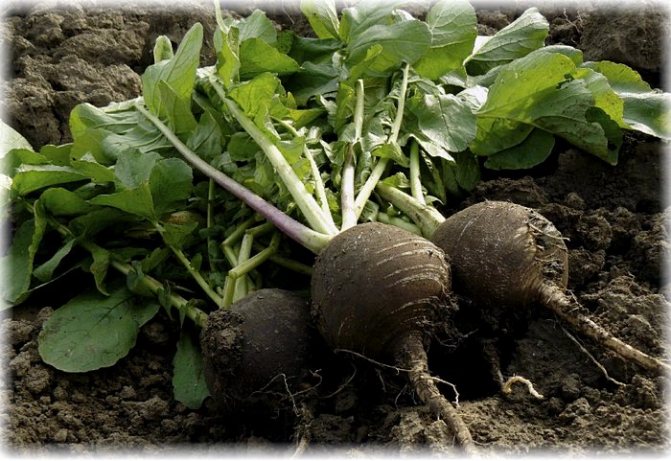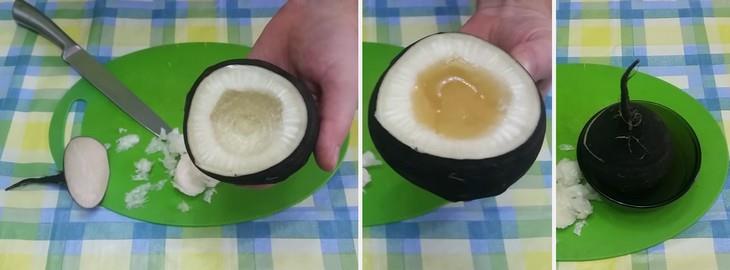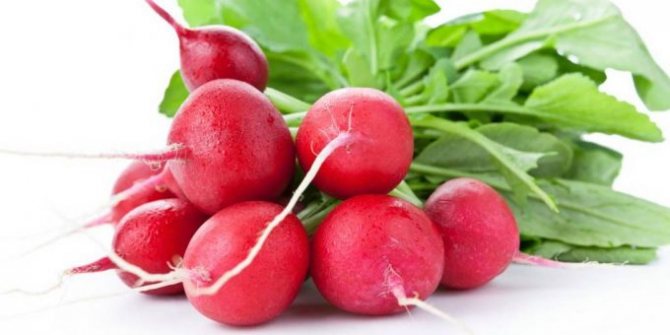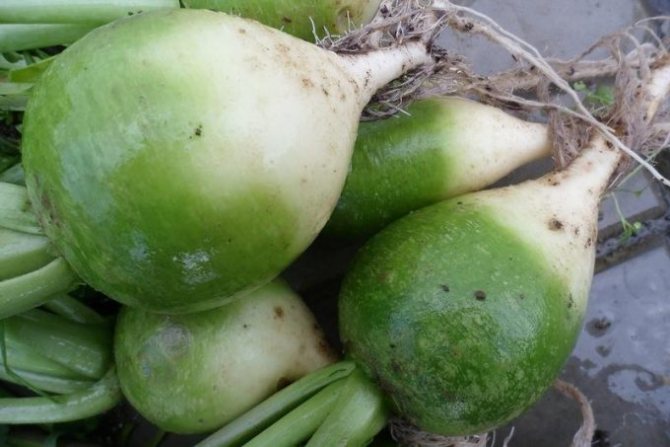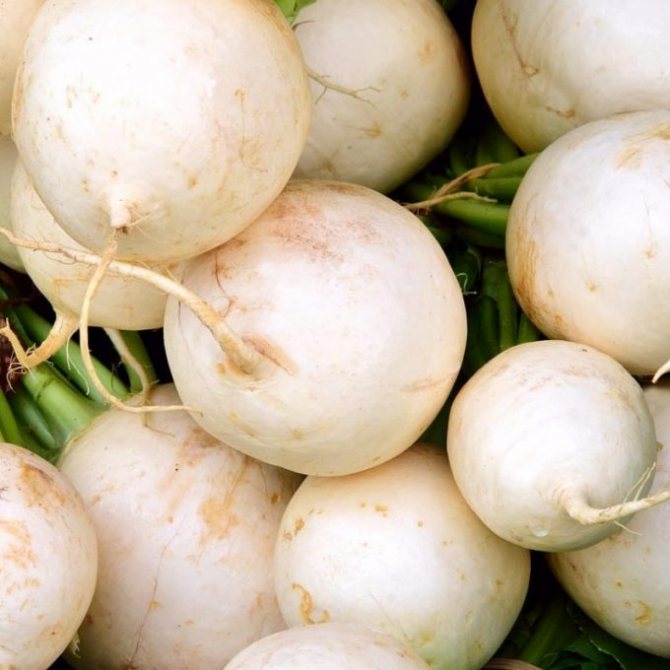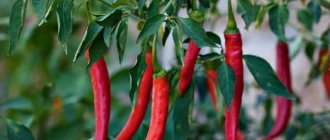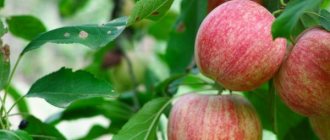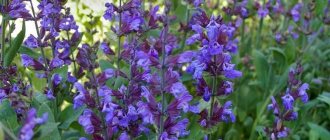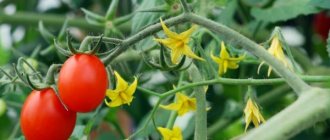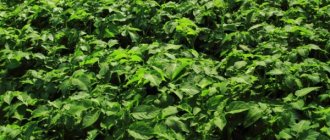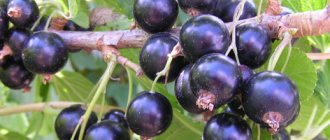Fresh vegetables and fruits that appear on the table in the summer make it possible to diversify the diet of adults and children, to create a supply of vitamins in the body for the winter. Radish is one of the most useful products, as it contains vitamins and microelements necessary for it. Not everyone loves it, because the essential oils it contains give a bitter taste and a specific smell. But you can cope with this and surprise the family with a delicious and healthy dish.
Botanical description
Black radish belongs to the type of sowing or garden radish (Raphanus Sativus L.), belongs to the biennial herbaceous plants of the cabbage family. It is the closest relative of radish, rutabagas, cabbage.
Found in the wild in Europe and Central Asia.
Root... The type of root system is pivotal. The roots are thickened and edible, penetrating to a depth of 25 cm.
Leaf arrangement... A rosette of prickly, rough, deeply dissected in several places lyre-shaped leaves departs from the roots. The leaves are bright green with a grayish or olive undertone, they have a height of 30-50 cm.
In the first year, the plant forms only a root crop and a rosette of leaves, after which it is usually harvested.
Inflorescence... If you leave the garden radish to grow, then in the second year it will have a tall, straight, well-branched stem, up to 1 meter high, on which clusters of small flowers with oval petals of purple or white color are formed.

Photo of a blooming radish
Flowering begins in May and lasts 35-40 days. Seeds are round, large, collected in pods, capable of germinating for up to 6 years.
Characteristics of radish for open ground
Radish belongs to the representatives of the Cruciferous family.
For open ground, biennial varieties of vegetables, or winter, and annual, have been bred. If you sow the plant early, then in the summer it will bloom, ending its growing season.... Winter varieties take longer to develop, so they do not have enough warm days to form seeds.
The features of the root crop include:
- resistance to frost, temperature drops;
- exactingness to light, soil fertility;
- moisture-loving;
- unpretentious care;
- yield, subject to the rules of agricultural technology.
The vegetable does not like thickened plantings. For proper growth and formation of large root crops, seeds need to be planted at a distance of 30–45 centimeters from each other with an embedment to a depth of 2–3 centimeters.
To store the radish all winter, you need to plant seeds in open ground no earlier than mid-June, you can at the beginning of July. For use in summer and autumn - at the end of April.


For culture, you need to feed the soil with mineral complexes with ammonium nitrate, superphosphate, potassium chloride. Before planting, it is better to fertilize the area with humus or compost in the amount of 3-4 kilograms per square meter.
During the summer, the beds with radish need weeding, loosening, watering.
Biological features
Radish is rather unpretentious, therefore it is widespread. It is cold-resistant, withstands frosts down to - 3 ° С, seeds germinate already at + 2 ° С. The most favorable temperature for plant growth is 16 - 18 ° C.
One-year early ripening varieties are planted with seeds in early April and harvested already 40 - 80 days after planting, mid- and late-ripening autumn and winter varieties are planted in July and harvested at the first frost, in October.
For rapid germination, the seeds are pre-soaked. The root crop is recommended to be grown on humus-rich loamy and sandy loam soils, although it is considered indispensable on heavy clay soils, drained and cultivated weakly acidic peatlands (considered a good green manure), cultivation on sod-podzolic soils requires mandatory fertilization.
Radish is not planted in the beds where representatives of cabbage previously grew (any cabbage, arugula, watercress, radish).
Brief history of origin and country of origin
The Mediterranean is considered the birthplace of the radish.
The ancient Greeks prized the root vegetable for its healing properties. Hippocrates advised the use of radish for pulmonary diseases and to improve vision, and Apollo, according to legend, gave for it as much gold as it weighs itself.
Radish was also cultivated in ancient Egypt, squeezing oil from seeds, and eating the root crop.
Radish came to Russia from Central Asia. Rare flour was used to prepare traditional dishes - tyuryu and ointment.
Chemical composition
100 g of black radish contains 36 kcal, 88 g of water, 6.7 g of carbohydrates, 2.1 g of dietary fiber, 1.9 g of protein, 1 g of ash, 0.2 g of fat, 0.1 g of organic acids.
Trace elements in 100 grams: potassium 357 mg, calcium 35 mg, phosphorus 26 mg, magnesium 22 mg, sodium 13 mg, iron 1.2 mg, there is also zinc, manganese and selenium.
Black radish contains vitamins C, A, B1, B2, B5, B6, E, PP, niacin.
Reference Radish has a specific smell due to the presence of sulfur; rafanol gives it a sharp bitter taste.
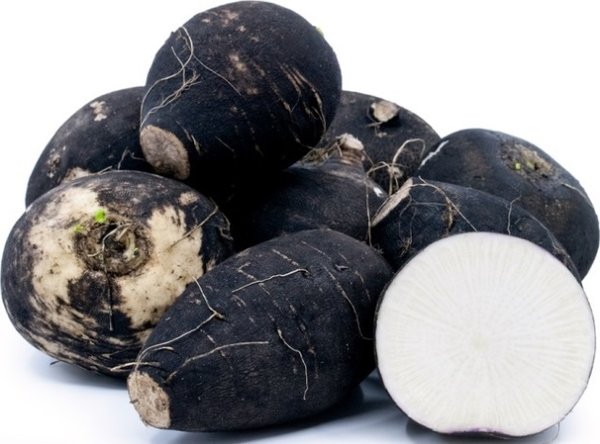

Do you need a radish in the garden?
Our gardeners undeservedly deprived the radish of attention. In ancient Greece, she was considered the queen of vegetables and was widely cultivated in her northern domains. In China, radish has been cultivated since ancient times as one of the main vegetable crops. Nowadays, in all countries, radish and its varieties are again receiving considerable attention. And for good reason.
The roots of all garden forms of radish contain vitamins, macro- and microelements, essential oils, fiber, amino acids, more than 6% sugar and 2.5% proteins. All parts of the vegetable are rich in lysozyme, which has a strong bactericidal effect.
Radish is used medicinally in the treatment of cough, gastritis, liver and gallbladder diseases, dyspepsia and other diseases. Radish juice is a good wound healing agent. Essential oils are obtained from seeds, which are used in industry, cosmetics and other areas of the national economy.
Benefit and harm
Of all types of radish, black is considered the most useful. Its composition is ideally balanced in terms of the content of trace elements, vitamins, and beneficial acids. It is better to use it raw, because in this case, all valuable substances are preserved in the root crop.
Beneficial features:
- thanks to dietary fiber, of which the radish contains a large amount, digestion improves, intestinal function is stimulated, constipation goes away, toxins are eliminated;
- increases the secretion of gastric juice, increases appetite;
- potassium in the vegetable makes the radish useful for hypertension and vascular diseases;
- radish helps to get rid of cholesterol plaques in blood vessels, removes excess cholesterol;
- cleanses the liver and kidneys, dissolves stones in the gall and bladder;
- removes excess fluid from the body, normalizes the water-salt balance;
- acts like an antibiotic. The lysozyme contained in the vegetable inhibits the growth of bacteria and fungi;
- increases immunity, acts as a general tonic;
- radish is also used in cosmetology: the juice is able to even out the tone of the face, whiten the skin a little; antiseptic properties help in the fight against inflammation and skin rashes;
- radish juice mixed with honey is used for hair care. A mask made from this product improves blood circulation to the scalp, stimulates hair growth, and relieves dandruff.
Possible harm and contraindications:
- Radish is contraindicated in case of individual intolerance to the product, the presence of allergies.
- You can not use radish with stomach ulcers, duodenal ulcers, with increased acidity in the gastrointestinal tract, inflammation in the liver and kidneys, with a history of heart attacks.
- Care should be taken with radish during pregnancy. You can not use it at all if there is a tone of the uterus, the threat of miscarriage.
- Banned radish and breastfeeding, until the child reaches 7-8 months.
- Even healthy people should eat radish in small quantities. A large amount of juice can irritate the mucous membranes of the stomach and intestines, and this is fraught with pain, colic and cramps. It is recommended to eat radish dishes no more than 2-3 times a week, the daily portion of a fresh vegetable is no more than 150 grams.
Subsection on the site
Medicinal properties of black radish.
What is it used for and where?
In folk medicine:
- Compresses are made from the gruel of the vegetable for pneumonia and bronchitis (reddens).
- Radish juice infused with honey is used for sore throat and cough.
- Fresh juice is used as a choleretic agent.
- To stop the growth of malignant tumors.
- The sulfurous essential oils found in black radish are good for stimulating the appetite and stimulating digestion.
- Used in the treatment of rheumatic pains.
In cosmetology: radish oil extract is used in the compositions of nourishing masks for the skin, body creams, and hair serums. It is used as an anti-inflammatory agent, eliminates puffiness, fights age spots and freckles.
Important! Due to the presence of a large amount of essential oils in the composition of the root vegetable, it is contraindicated in pregnancy.
Treatment
Due to its composition, black radish has diuretic, choleretic, analgesic, expectorant, cleansing and antispasmodic effects.
In combination with honey, it is the most popular folk remedy for coughs. To do this, take a large root crop, cut out a cone-shaped notch, which is half filled with honey. From honey, radish quickly gives juice, after 2-3 hours, but it is better to let it brew overnight, and then take a tablespoon 3 times a day.


Gruel from radish pulp is used externally for radiculitis, osteochondrosis. The grated radish is distributed on the fabric, which is wrapped around the lower back or other sore spot. This compress has a good analgesic effect.
The juice is used to get rid of parasites and cleanse the body. To do this, squeeze the juice out of the radish with a press or with the help of a juicer and take it after meals, 30 grams 3 times a day. At the time of treatment, meat and eggs, starch, and fatty foods are excluded from the diet. The treatment takes about 3 liters of juice.
Also, radish juice in the form of an infusion is used to treat gout, joint diseases, radiculitis and osteochondrosis. The infusion is prepared from 0.5 liters of juice, 0.5 liters of vodka, 3 glasses of honey and 9 tablespoons of salt. All this is infused for 2 weeks in a dark place. This medicine can be used both internally and externally.
A mixture of radish, carrot and beet juice in a ratio of 1: 2: 6 is considered an excellent treatment for anemia.
Attention!
Before using radish as a medicine, you should consult your doctor.
White radish salad recipe
Salads with white radish as the main dish are found in many cuisines of the world. It is worth trying to cook the dish the way Turkish housewives do it.
Products:
- White radish - 500 gr. (For the first time, you can reduce the portion by half for the sample).
- Sweet peppers - 1-2 pcs.
- Carrots - 1-2 pcs. (depends on the size).
- Bulb onions - 1 pc.
- Jusai (wild hot onion) or green onion feathers.
- Garlic - 3-4 cloves (for spicy lovers, you can take more).
- Special dressing, salt.
Cooking algorithm:
- Cut radish and carrots (peeled, washed) into very thin strips, lazy "cooks" can grate. Grind these vegetables with salt until juice forms.
- Peel and rinse garlic, onion, pepper. Slice.
- Rinse jusai or feathers, blanch to eliminate bitterness.
- Mix all the vegetables in a salad bowl.
- For the dressing sauce: mix 2 tbsp each. l. vegetable oil and vinegar (3%), add a little sugar, ground red pepper. There is no need to add salt, it was used earlier for grinding radishes and carrots.
- Season the salad. As a decoration, you can use slices of pepper, carrots, herbs.
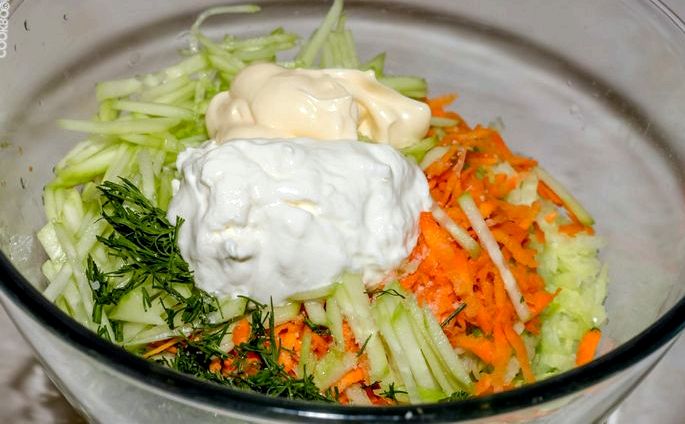

Slimming use
Radish is used for weight loss as an additional food product; it is not used in mono-diets. It is low in calories, so it is suitable for those who want to lose weight. You can add it to salads made from fresh vegetables, boiled beef or chicken breast. Radish removes excess water from the body and cleanses the intestines of toxins, which contributes to weight loss.
It also prevents the accumulation of fats and salt deposits, which has a beneficial effect on the appearance. Enzymes and essential oils of radish help to digest heavy food, improve metabolism, as a result of which extra pounds do not accumulate.
What is the difference from other species?


Radish can be different, but each species has its own varieties. So it is with the black one.
Black round winter radish. Mid-season variety. The vegetable contains many essential oils, vitamins and minerals. The peel is smooth, black. The pulp is white, dense, spicy, with a bitter taste, which is considered the most "correct" among the brethren. Possesses good keeping quality in relation to other varieties. High yield and immunity to diseases.
Points for which the difference is made:
- ripening time;
- useful properties and content of vitamins and essential oils;
- taste and color;
- root crop shape;
- yield;
- keeping quality.
Varieties and types
| Characteristics | ||
| Early varieties | Panther | Grown in a greenhouse or open field. Fruits are black, smooth, round, with a diameter of 10 - 12 cm. The pulp is very juicy, white, has a sweet-spicy taste. Root vegetables are intended for fresh consumption. |
| Black Kulata | It is grown mainly in the open field. It is sown in May, the harvest takes place in 45-47 days. Fruit color is black, skin is leveled, smooth. The diameter of one root crop ranges from 5 to 10 cm. They are round-flat in shape. The pulp has high palatability: juicy, pleasant mild taste, with a pale white color. The variety is very disease resistant. Easily treats pests. | |
| Mid-season varieties | ||
| "Wonderful" or "Wonderful" | The fruits are round, black in color, weighing no more than 350 grams. Ripens in 80-90 days. Sowed in mid-June. It is stored all winter without losing its juiciness. | |
| Squirting black | Root crops are black, round in shape, the skin is thin, smooth. The pulp is white, with a slight sharpness, starchy consistency. Fruit weight is about 250 grams. | |
| Late-ripening varieties | Winter round black | The most useful of all varieties. Ripens 110-120 days after sowing. Root crops are spherical or slightly flattened, weighing about 250 grams. The skin is black, matte, rough, with grooves. The pulp is juicy, spicy, snow-white. Possesses excellent productivity and keeping quality. |
| Healer | The fruits are black, round, the flesh is white and crispy. The variety was created for commercial purposes. Differs in high productivity. | |
| Winter long black | Elongated roots, black skin, matte. Root weight 250-400 grams. The pulp is fibrous, but juicy and crunchy.Ripens in 100-120 days. | |
| Chernavka | It is intended for fresh consumption and for making juices. Cold resistant. Seedlings can withstand frosts down to -3 degrees. Fruits are black, round. The diameter is about 10 cm. The weight of one fruit is 250 - 270 g. |
Radish and meat salad
It is interesting that in some families on the New Year's table you can see not only the traditional salad "Olivier", but also vegetable dishes based on radish. Perhaps because this vegetable is well stored, and by the middle of winter there is less bitterness in it. Today, daikon has been added to the traditional white and black radish, which also goes well with meat.
Products:
- Radish - 400 gr.
- Boiled chicken meat - 200 gr.
- Bulb onions - 1 pc. (+ vegetable oil for browning).
- Salt.
- Mayonnaise.
- Greenery for decoration.
Cooking algorithm:
- Prepare radish for salad in the traditional way - peel, rinse. Grate, ideally on a Korean-style carrot grater, then you get a beautiful thin vegetable straw.
- Boil the chicken fillet, adding onion, spices and salt. The broth can be used for other dishes.
- Cut the cooled boiled meat into thin strips.
- Rinse the peeled onions, cutting into thin half rings. Saute until a pleasant golden shade.
- Mix everything and season with mayonnaise.
- The salad should stand in a cold place for 1 hour before serving, now it remains to give it a beautiful look, sprinkle with fresh herbs, and invite guests to the table for tasting the novelty.
Landing
Early varieties of radish begin to be planted in March, the seeds germinate at temperatures from +2 ° C. They ripen in 60 - 75 days. They are eaten in summer, they cannot be stored. Late varieties are planted in July and they ripen in 105 - 120 days. These varieties are: Doctor, Chernavka, Negritanka, Winter round black. These varieties, on the other hand, are excellently stored.
Before planting, the seeds must be soaked in a saline solution (dissolving 3 tablespoons of salt in 1 liter of water), then wash and hold for another day in a 2% solution of potassium permanganate or 1% iodine solution.
The soil for planting should be prepared in advance. Radish grows well on soils rich in humus. It does not recommend planting it on the soil where cabbage, radish, carrots, beets previously grew. Excellent precursors for planting radishes are legumes, pumpkin, onions, cucumbers, garlic, and eggplants. Before planting, the soil must be loosened, mineral fertilizer applied (60-65 g of superphosphate, 20 g of urea, 15 g of potassium chloride per square meter). If the soil is depleted or poor, compost is added. It is not recommended to introduce manure - the fruits will be large, but with low taste.
The seeds are sown into the ground to a depth of 2-3 cm, the distance between the plants should be about 10 cm, the width between the grooves - 30-35 cm. Then the grooves are covered, slightly compacting the soil, and watered abundantly.
Growing
Growing a radish won't be a big deal. After planting, the beds must be covered with ash (to protect against aphids, red fleas and molluscs) and covered with non-woven material.
Shoots appear in 3-5 days.
For a radish to grow large and juicy, it needs a lot of moisture. Plants planted in spring are watered once a week. Winter varieties planted in summer are watered 1-2 times a month, in the morning or in the evening. For each square. meter takes 10-12 liters of water.
The soil should be loosened regularly, avoiding the appearance of a hard crust. After the appearance of the second leaflet, the seedlings are thinned out.
You need to feed the plants twice: during the appearance of cotyledon leaves and after another week. 2 weeks before harvesting, feeding should be stopped.
Reviews of gardeners
podruga
maybe your soil is just too acidic? such a radish does not like it still grows poorly in the shade, on fresh manure and in dense plantings
interes
My black radish also cracks when, after the summer heat and sushi, the autumn rains begin. I don't see anything wrong))
Harvesting and storage
Usually from 1 sq. meters, 2-4 kg of root crops are harvested.Early (summer) varieties ripen in 30 - 60 days, their harvesting begins at the end of May and lasts the entire summer period, in several approaches. Summer radish is poorly stored, usually consumed within a week after harvest. It will stay in the refrigerator in a leaky bag for up to 20 days. These varieties are not suitable for long-term storage.
If you need to stock up on radish for the winter, you should turn to the autumn and winter varieties. Mid-ripening (autumn) varieties ripen after 80 days from sowing, late-ripening (winter) varieties are harvested after 110-120 days from planting. In autumn, the maximum amount of nutrients accumulates in root crops. You need to remove vegetables before the first frost. Frozen root vegetables cannot be stored - they will simply rot. Dig up the radish carefully, taking care not to damage the root crop. The tops are cut with a knife, leaving the tip about 2 cm, the roots are also carefully removed. The dug up roots are cleaned of the ground and dried in a dark room. Raw vegetables will quickly mold.
The radish should be stored in wooden boxes, sprinkling each layer with sand. The ideal place would be a cool basement, cellar. In the absence of such, a refrigerator will do. The temperature at the storage place should not fall below 0. When stored in a cellar, the beneficial properties of the radish are not lost for up to six months, the root crop is stored in the refrigerator for about a month.
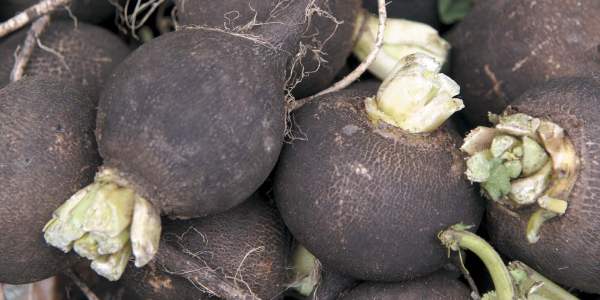

What to choose
As a rule, after winter, all summer residents want to get a harvest of vitamin vegetables early. A radish is ideal for this purpose. White radish is considered the most spicy, it is rarely put in salads, and even then in small quantities. Most often, it is left for the winter, pickled, spicy sauces and snacks are made from it, it is it that is called bitter.
The black radish is not as spicy as it is considered to be the healthiest. Salads and medicinal tinctures are made from it, they are eaten in summer and winter. We grow Chinese and Japanese radishes that are not too spicy, they are also eaten in salads or pickled.
The earliest radish is planted in March, it is frost-resistant and is able not only to endure spring cold snaps, but even germinate at low temperatures. Here she also gets on our table in the spring. After April 25, early ripening varieties are sown, which give root crops in June. But later, in June, they plant those vegetables that are going to be stored for a long time, put in the cellar for the winter.
Diseases and pests
The most dangerous pests are:
- cruciferous fleas and cabbage fly damaging plant roots.
- locusts, grasshoppers, slugs - they eat leaves
- bears, wireworms - eat a root crop
Fight them will help:
- Deep tillage in autumn so that pests do not get out to the surface.
- Regular control of weeds, especially cruciferous weeds, which feed pests.
- Cleaning from the site and subsequent burning of plant residues on which wintering pests, eggs or larvae, as well as pathogens, remain.
You can treat the plants with infusion of potato tops or tomato stepsons. This will get rid of leaf-eating pests: aphids, ticks, caterpillars. Also, a decoction of wormwood, an infusion of bird droppings is used for pests. Chamomile infusion can be used against larvae of leaf-eating pests. Celandine powder or tobacco dust will help get rid of fleas, cabbage whites, moths.
Pest control chemicals should be applied no later than two months before harvest. An effective method is spraying with Iskra DE solution: 1 tablet (10 g) per 10 liters of water per 1 hundred square meters.
The most common illnesses include:
- blackleg. The lower leaves and the top of the root crop darken and become thinner. The root crop becomes soft, dark on the cut. To fight, you should disinfect the soil with bleach. In the spring, sulfur powder will help, poured into the holes a few days before planting the seeds.
- powdery mildew, affects stems and leaves. They are covered with a white bloom, the plant lags behind in development. Treatment with infusion of garlic, spraying seedlings with copper chloride (0.4% suspension or 40 g per 10 l of water) or Bordeaux liquid (100 g of copper sulfate and 100 g of lime per 10 l of water), feeding with ammonium nitrate before planting in priming.
- keela, affects the roots. They form plaques and swellings, nutrients cease to flow to the plant, it lags behind in development, the lower leaves wither. To combat it is necessary to disinfect the soil with ash and bleach, feed the plants with milk of lime, followed by loosening the soil. The planted bushes must be hilled.
reference
These diseases develop in high humidity, so they are more common in the northwestern and northern regions. Correct crop rotation will help prevent disease. Cruciferous plants should not return to their old place earlier than after 3-4 years.
Compatibility with other vegetables
When growing vegetables in the garden, you may notice that the harvest becomes more scarce from year to year. The reason is the lack of a normal crop rotation when planting vegetables. Violating the rules of compatibility, you can not count on a bountiful harvest. If you plant compatible crops, you will greatly facilitate the care process for yourself, since they need approximately the same procedures and conditions.
Planting plants that are incompatible with radish can lead to a number of problems:
- the development of fungal infections;
- attracting pests;
- poor development of culture;
- small harvest.
The best predecessors of white radish are legumes:
- lentils;
- peanut;
- beans;
- peas.
But you can plant after such crops:
- cucumbers;
- peppers;
- zucchini;
- greenery;
- eggplant.
You cannot plant a radish after representatives of the Cruciferous family:
- carrot;
- horseradish;
- cabbage;
- beet;
- radish.
After these crops, radish can only be planted after 3-4 years.
Black radish for children
Raw radish is not given to children under 3 years old. This is due to its irritating effect on the delicate gastrointestinal tract of babies, in addition, it is difficult for children to digest the coarse fiber of the radish, which is fraught with bloating and other intestinal problems.
After 3 years, you can gradually include it in the children's diet. It can be added to salad with cucumber and potatoes, lean meat, green peas. The proportion of radish in the salad should be low, no more than 30-40 grams. Children can eat radishes once a week. Before cooking, the root crop must be soaked in water, this will rid it of excess bitterness that children do not like.
Often, radish with honey is given to children when they cough. This is a natural and effective remedy, and quite tasty. The syrup is prepared in the same way as for adults (by adding a spoonful of honey to the hole cut in the root vegetable). You can give this medicine to children from 1 year old, 1 teaspoon 3 times a day.
Attention!
Do not give radish syrup with honey if the child is allergic to honey and bee products!
Black radish is an easy-to-grow vegetable, but valuable for humans. Consuming it in reasonable amounts will help maintain and strengthen health, improve well-being and prolong life.
How to make daikon radish salad
The radish, which came to us from China, contains a large amount of fiber, pectin, vitamins B and C, but, most importantly, it has a pleasant taste, since it does not contain mustard oils.
Products:
- Daikon radish - ½ pc.
- Antonov apples (any other, with a sour taste) - 2 pcs.
- Fresh carrots - 1pc.
- Salt.
- Dressing - mayonnaise or healthier unsweetened yogurt.
- Dill for decoration.
Cooking algorithm:
- Rinse the daikon, peel, grate. A Korean carrot grater is the best option for this salad.
- Using the same grater, chop the carrots and apples, previously, of course, washed, peeled.
- Mix vegetables in a salad bowl, add mayonnaise / yogurt. Sprinkle with finely chopped fresh dill.
It's not a shame to put such beauty on the festive table!



